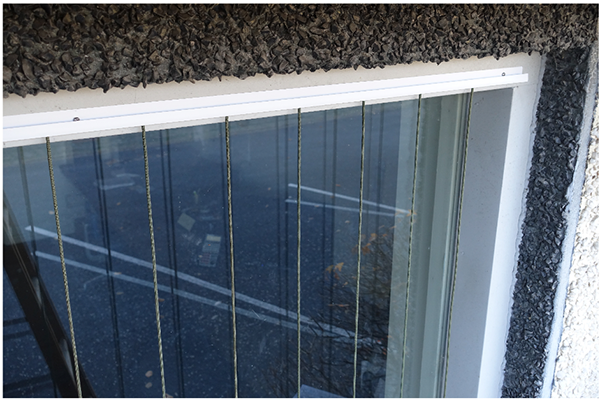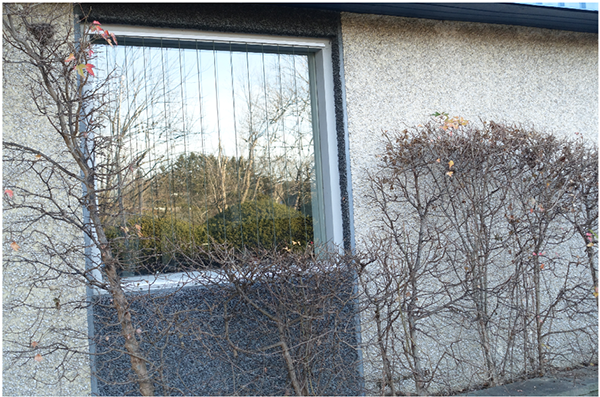How to Make Acopian BirdSavers using a solid top horizontal support, such as Vinyl J Channel, wood moulding, aluminum extrusion, small diameter PVC pipe, or anything else.
In this example, for the top horizontal support, we will use the readily available, inexpensive, and good looking, Vinyl J Channel (also called Drywall J Bead). This is available at Home Depot and costs about $1.70 for a 10 foot long piece. Any other material could also be used for the top horizontal support; such as wood moulding, aluminum extrusion, small diameter PVC pipe, or anything else.

**** Because nylon cord can become quite elongated at times depending on weather conditions, polyester cord should be used when the BirdSavers cords will be attached at both the top and the bottom for cords that will be longer than about 8 feet. ****
Step 1: Measure the width of the glass.
Then use these tables to determine how many cords will be needed. For DIY Acopian BirdSavers, we recommend spacing the cords 4 inches apart, but you can read more about cord spacing here. If there is more than one pane of glass in your window, you may want to have a look at the “Acopian BirdSavers Cord Spacing Examples” before taking any measurements.
See FAQ – How far apart should I space the BirdSavers paracords?
Step 2: Drill that number of holes in the J channel.
For the number of cords you will need (which you determined in Step 1), drill that number of holes in the J channel at the distance apart you also decided upon in Step 1. The holes should be just a little bit larger diameter than the diameter of the paracord, so that the paracord will easily fit into the hole, but the cord with one knot tied in it won’t go through the hole. Leave an inch or so of extra J channel material beyond the holes on both of the ends.

Step 3: Decide how you are going to mount the BirdSavers.
You can use small screws (#6 x 3/8” stainless steel sheet metal screws work very nicely), or you can use velcro.
If you are going to mount with screws, drill mounting holes in the J Channel. If you are going to mount with velcro, cut the velcro pieces and attach to the J Channel.


Step 4: Determine the length of the paracord pieces you will need.
You have two choices:
Option #1, the option we prefer (because it looks so cool!), is to make the BirdSavers so that the cords do not go all the way to the bottom of the glass. It looks more aesthetically pleasing when you can see an inch or two of space between the bottoms of the cords and the bottom of the glass, like in the photo below:
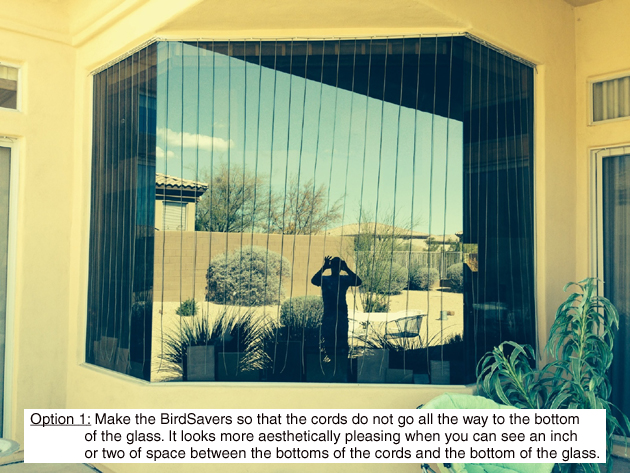
Option #2 is to have the cords go all the way to the bottom of the glass and beyond, like in the photos below:

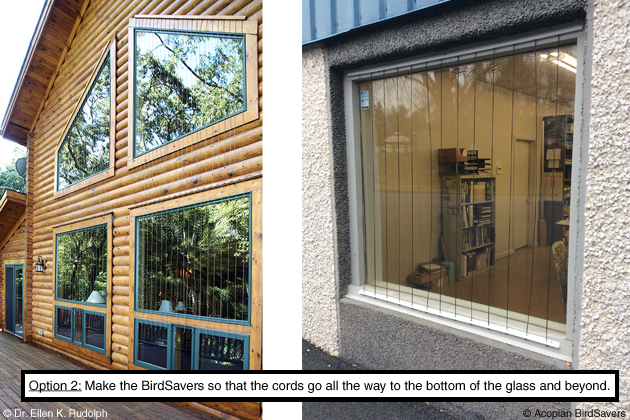
To the birds it makes no difference which option you choose; you will achieve a 90 to 100 percent reduction in bird-window collisions with option #1 or option #2.
If you are making Option #1 BirdSavers:
Determine the length of the paracord pieces you will need so that when they are hanging they stop about an inch or inch and a half above the bottom of the glass. A knot will be tied at the very end of each paracord to hold the paracord from slipping through the hole you drilled in the J Channel. That knot, which will be at the top of the BirdSavers, will use up about one inch of paracord, so add that one inch to the length of the paracord you will need.
If you are making Option #2 BirdSavers:
Determine the length of the paracord pieces you will need so that they stop wherever you determine you would like them to stop. A knot will be tied at the very end of each paracord to hold the paracord from slipping through the hole you drilled in the J Channel. That knot, which will be at the top of the BirdSavers, will use up about one inch of paracord, so add that one inch to the length of the paracord you will need.
If you decide to attach the cords at the bottom, here are a few methods. Some people worry about wind tangling the cords, and therefore decide to attach the cords at the bottoms. But this problem does not happen as often as you might think. You can read more about that here.
About the Paracord:
Most paracord will shrink after getting wet. This shrinkage can vary from around 2% to over 12%! If you choose to make your own BirdSavers using Option #1 above, this shrinkage could eventually leave an area at the bottom of the window with ‘exposed’ glass (although small) that a bird could fly into. Because of this, you might want to consider soaking the paracord in a bucket of hot water for a few hours and then let it dry (to ‘pre-shrink’ it) before making your BirdSavers. This procedure also serves to eliminate any “kinks” that may be in the cord as a result of the tight packaging when it was purchased (see the “Straighten Kinks & Pre-shrink Paracord to Make Acopian BirdSavers” video.)
We have been using dark olive green colored parachute cord (550 paracord) to make Acopian BirdSavers for many years. Also commonly called Olive Drab color, the 550 paracord has a diameter of approximately 1/8”. Using this cord for Acopian BirdSavers has proven very effective, as well as aesthetically pleasing. We are fairly certain though, that any dark color, or for that matter probably any color or any type of cord, will be just as effective as the dark olive green color paracord.
**** Because nylon cord can become quite elongated at times depending on weather conditions, polyester cord should be used when the BirdSavers cords will be attached at both the top and the bottom for cords that will be longer than 8 feet. ****
Step 5: Cut the paracord to the length you need and melt the ends with a match.
Before you cut any paracord, be sure you have read the "About the Paracord" section above this step. The "About the Paracord" section has a video you should watch that shows you how to pre-shrink the paracord, as well as straighten any kinked paracord.
Step 6: Tie a single knot at one end of each paracord
Tie a single knot at the very end of each piece of paracord. Contrary to common belief, there doesn’t need to be a “tail” to make the knot secure. The knot can very secure without the ugly looking tail; watch the How to Tie a Paracord End Knot Without a Tail video.
After all of the knots have been tied for each cord, then thread each paracord piece through each hole in the J Channel. Your BirdSavers is now ready to be installed on the window!
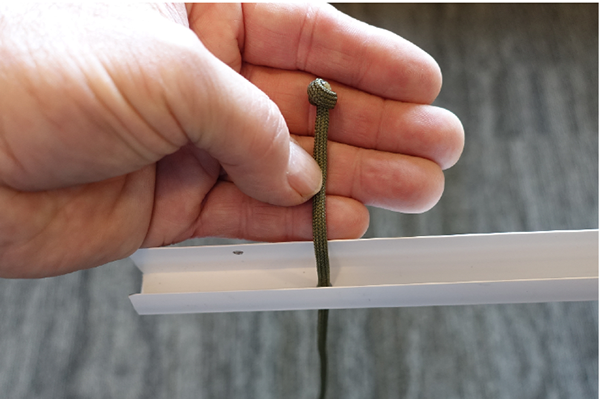

Step 7: Positioning the BirdSavers
Hold the BirdSavers against the window in the position that it should be in when it is in it’s final position – Position the BirdSavers so that the two ‘hanging cords’ on each end are the same distance from each side of the window. When you are comfortable with where the BirdSavers will hang, you can attach the BirdSavers to the building, using either the screws or the velcro.
Step 8: Finishing Touches
After the BirdSavers is installed, any kinks or curves in the ‘hanging cords’ can be smoothed out by holding the offending cord near the top with your fingers and then pulling (straightening) the bottom of the cord with your other hand.
Step 9: Where are your BirdSavers?
Final installation of Completed BirdSavers on Window:
